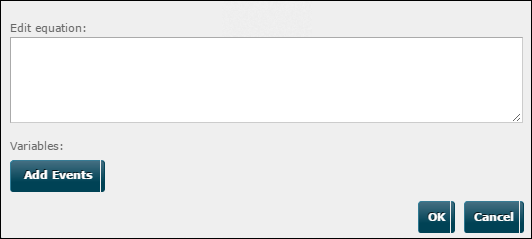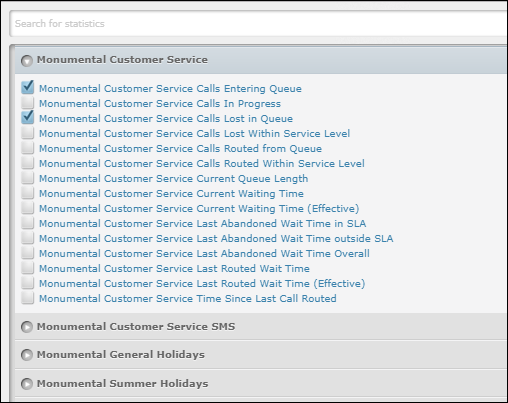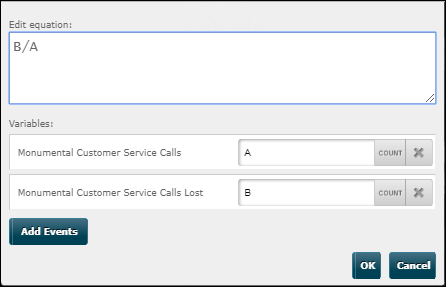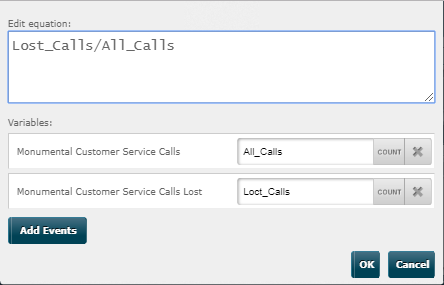Design a Custom Real-Time Statistic
This is a procedural topic for administrators describing how to design a custom real-time statistic from available real-time events (sometimes referred to as a formula).
For example, there is no real-time statistic for displaying the percentage of lost calls for a particular queue. You can, however, create a custom statistic to display this value by using the available real-time events Calls Lost in Queue and Calls Entering Queue for that queue.
|
Calls Lost in Queue ÷ Calls Entering Queue x 100 |
An example of a service level calculation from available real-time events is:
|
Calls Routed from Queue Within Service Level ÷ (Calls Entering Queue - Calls Lost From Queue Within Service Level ) x 100 |
You can design custom real-time statistics directly in the following real-time modules:
This topic also covers the following related tasks:
Edit a Custom Real-Time Statistic
Change the Name of a Real-Time Statistic
Delete a Custom Real-Time Statistic
Prerequisites
- You have logged in to storm with your user log in credentials and then launched the VIEW application. See Log in to storm and Launch VIEW.
- You are familiar with the VIEW Dashboard Interface.
- You have created a real-time dashboard. See Create a Dashboard for Real-Time Statistics.
Basic Configuration
-
Click
 in the module's title bar to display its configuration parameters.
in the module's title bar to display its configuration parameters. -
Do one of the following depending on the module type:
|
Module |
Procedure |
|
Click the Add Formula button. |
|
|
Select the Formula option and then click the Edit button. |
-
Click Add Events.

-
Select the events that are to be used in the calculation and then click OK at the bottom of the dialog.

Note: at the bottom of each category of events, click the Show More link to show more entities as necessary. To quickly search for an entity or an event, type its name in the filter field at the top of the dialog.
For a complete list and descriptions of all events available in this dialog, see Real-Time Events Selector.
-
Design your formula by arranging the variables (the letters assigned to the events) in the equation editor and by adding the required operators:

For supported operators, see Appendix A: Supported Operators For Real-Time Statistics.
You can overwrite the letters with more meaningful names using alphanumeric characters only. There must be at least one letter in the name and no spaces (underscores are allowed). Names are not case-sensitive.

Note: the names in the editor must match the variable names exactly.
If required, click the Count button and then select another type of statistic to display for the event. It is up to you to ensure that the selected type is meaningful for the event.
|
Type of statistic |
Description |
|
Update Count |
The number of times the statistic has been incremented today. |
|
Current Value |
The current value of the statistic. This can be a discrete value such as a string, or a cumulative value such as a running total of collected funds. |
|
Minimum Value |
The lowest value for the statistic today. |
|
Maximum Value |
The highest value for the statistic today. |
|
Average Update Value |
The Current Value divided by Update Count. Use this for a cumulative sequence of values (that is, where the current value is the sum total of all values today). An example of a cumulative sequence is £15, £20, £60, which could represent the donations to a charity as they build up. The Average Update Value is then £60 (current cumulated value) divided by the update count of 3, giving £60 ÷ 3 = £20. |
|
Use this for a non-cumulative sequence of values (that is, where the current value is NOT the sum of all values today). For a queue wait time statistic, which updates every second, the Average Value is the rolling average of all callers in the queue calculated every second. For other statistics, the average is the sum of all Current Value values divided by Update Count. In the non-cumulative sequence of 5, 10, 3, 3, the Average Value is 5 + 10 + 3 + 2 (the sum of all values) divided by the update count of 4, giving 20 ÷ 4 = 5. |
-
Click OK to commit the changes to the new statistic and close the dialog.
Related Tasks
|
Task |
Procedure |
|
Click the |
|
|
Edit the event name directly in the module configuration panel:
|
|
|
Click the statistic's |





